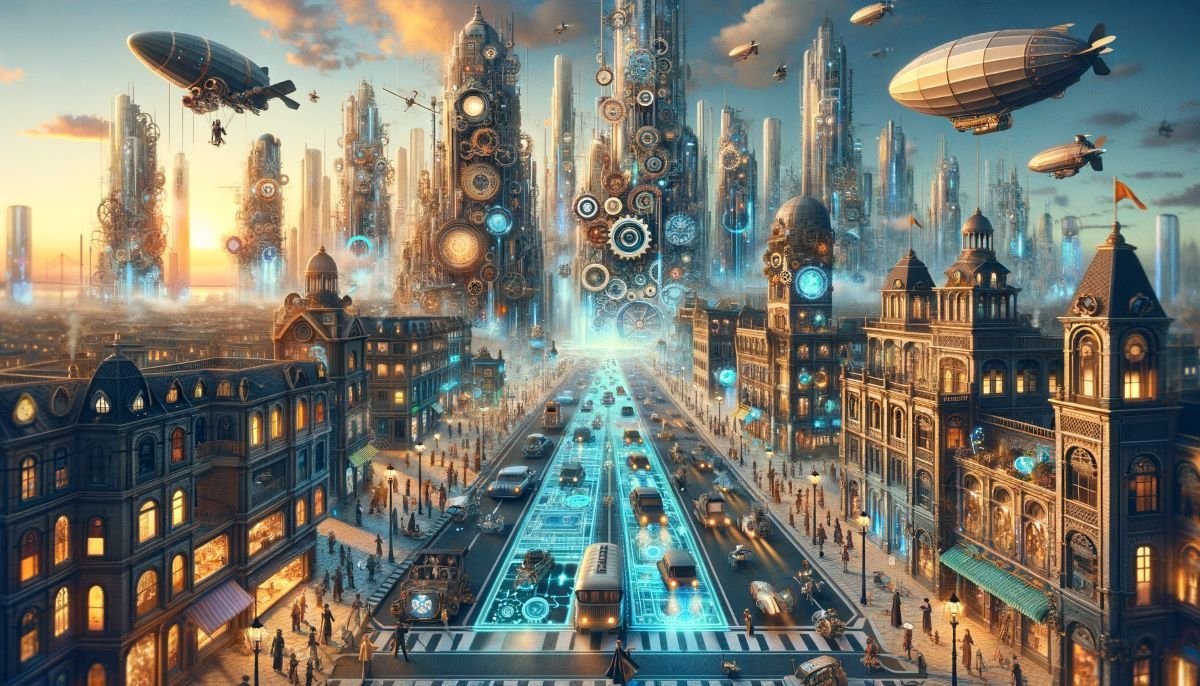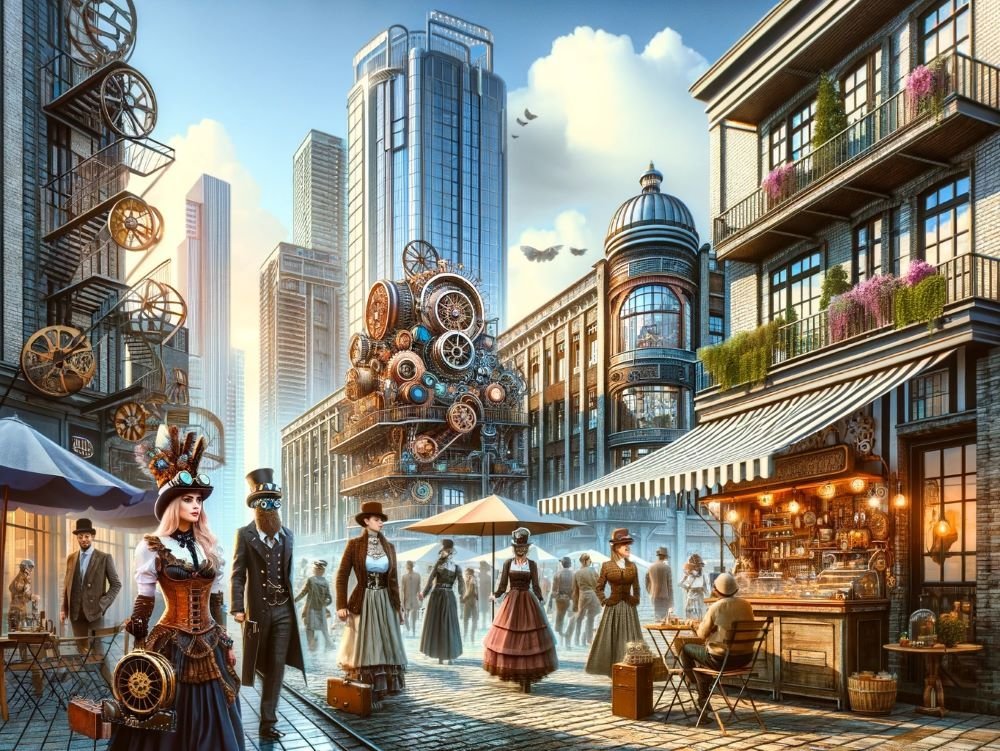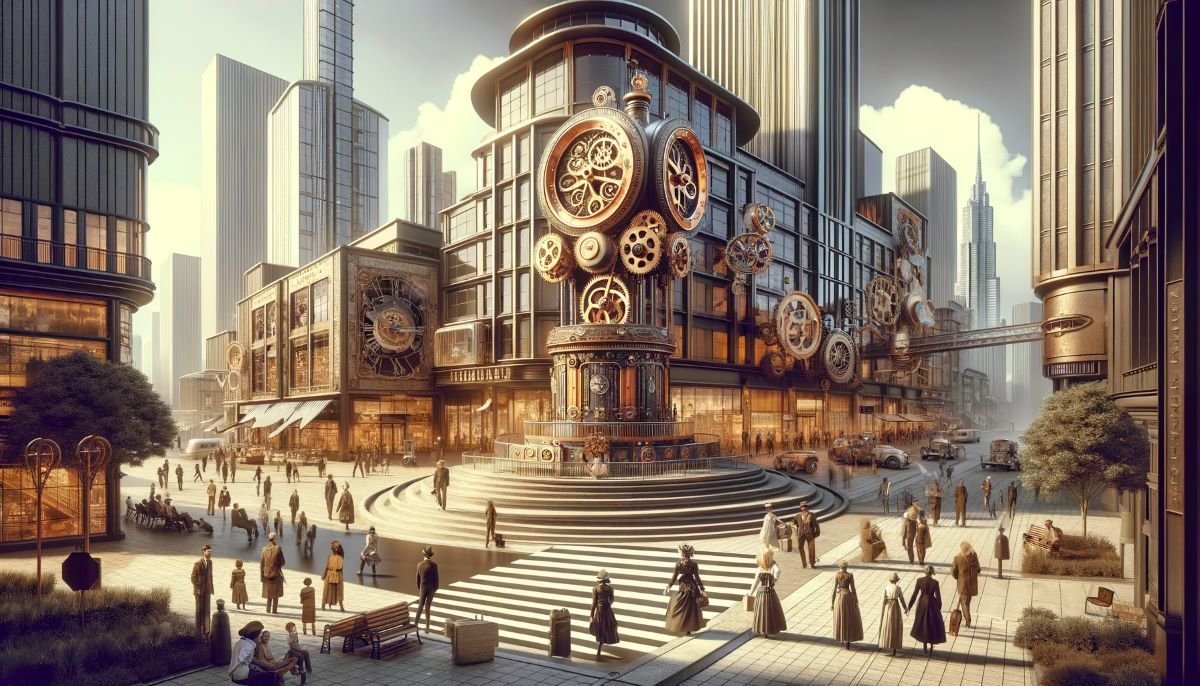Welcome, adventurers and dreamers, to an exploration of the future of Steampunk Fantasy. This genre, a vibrant amalgamation of Victorian elegance, futuristic innovation, and imaginative storytelling, continues to captivate and inspire. As we stand on the cusp of tomorrow, let’s delve into what lies ahead for this beloved genre. Grab your goggles and tighten your corsets; we’re about to embark on a journey through time, technology, and creativity.
What is Steampunk Fantasy?
Understanding the Genre
Ahoy, curious minds and creative spirits! Before we set sail into the vast and unpredictable ocean of Steampunk Fantasy’s future, it’s essential to have a sturdy map of where it all began. So, what exactly is this fascinating genre that has captured the imagination of so many? Let’s dive into its core, explore its quirky origins, and uncover the key elements that make it tick (or should I say, ‘tock’ in true Steampunk fashion!).
Steampunk Fantasy: A Whirlwind of Gears and Dreams
At its heart, Steampunk Fantasy is a delightful concoction of the past, present, and future. Imagine a world where Victorian elegance meets futuristic innovation, where airships rule the skies and clockwork devices hold the secrets of the universe. It’s a genre that takes the historical backdrop of the 19th-century Industrial Revolution and infuses it with a speculative twist, often incorporating elements of science fiction and fantasy.
A Journey Through Time: The Origins of Steampunk
The roots of Steampunk are as intricate as the inner workings of a pocket watch. The term ‘Steampunk’ was coined in the late 1980s, but its influences date back much further. Literary greats like Jules Verne and H.G. Wells are often cited as the grandfathers of Steampunk, with their visionary tales of underwater voyages and time travel. However, it wasn’t until writers like K.W. Jeter and Tim Powers played with these retro-futuristic ideas in their novels that Steampunk began to take shape as a distinct genre.
Gadgets, Goggles, and Gears: The Key Elements
What sets Steampunk Fantasy apart are its unmistakable elements. Picture brass goggles, leather corsets, and top hats fitted with all manner of gadgets. It’s a visual and narrative feast, featuring steam-powered machinery, intricate inventions, and a strong sense of adventure. Characters are often eccentric inventors, dashing airship pilots, or cunning adventurers, all navigating a world where technology and tradition collide.
From Niche to Mainstream: The Evolution of Steampunk
Over the years, Steampunk has evolved from a niche literary genre to a cultural phenomenon. It’s influenced fashion, music, art, and, of course, film and television. What was once a subgenre of science fiction has blossomed into a full-fledged community, with enthusiasts around the world donning their Steampunk best at conventions and immersive events.
So, as we stand on the brink of tomorrow, peering into the foggy future of Steampunk Fantasy, we’re armed with a deeper understanding of its past and present. This genre is more than just a style or a set of tropes; it’s a dynamic and ever-evolving narrative landscape that challenges us to imagine and innovate. Stay tuned, fellow adventurers, for the journey into the future of Steampunk Fantasy is sure to be as thrilling and unpredictable as the genre itself!
Real-Life Inspirations
Oh, what a time it was! The Industrial Revolution, a period of immense change and innovation, serves as the beating heart of Steampunk Fantasy. This era, with its steam engines, clanking machinery, and smoke-filled skies, has deeply influenced the genre, providing a rich historical backdrop for the fantastical worlds Steampunk creates. But it wasn’t just the machines and the smog; it was the people, the brilliant minds whose inventions changed the course of history, that have truly inspired the spirit of Steampunk.
The Industrial Revolution: A World Remade
The Industrial Revolution was a period of dramatic change from the late 18th to the early 19th century, transforming societies from agrarian economies to industrial powerhouses. It was a time of great contradiction – of progress and poverty, innovation and exploitation. This era of contrasts, with its grand advancements and profound societal shifts, provides fertile ground for Steampunk narratives, which often explore the tension between human ingenuity and the darker sides of industrialization.
The Mavericks of Machinery: Real-Life Inspirations
Consider Isambard Kingdom Brunel, a visionary engineer whose groundbreaking designs include the Great Western Railway and the SS Great Britain, the world’s first iron-hulled steamship. His bold projects and innovative spirit embody the Steampunk ethos of pushing boundaries and reimagining the world.
Then there’s Nikola Tesla, the enigmatic inventor whose work with electricity was both brilliant and ahead of its time. Tesla’s coil and concepts of wireless communication are the stuff of Steampunk dreams, reflecting the genre’s fascination with advanced technology and its potential to reshape society.
Aesthetics Forged in Steam and Steel
The Industrial Revolution wasn’t just about the people; it was about the aesthetic it created. The steam engine, the cornerstone of this era, is a symbol of power and progress that has become synonymous with Steampunk. The architecture of the time, with its imposing factories and intricate ironwork, and the fashion, with its utilitarian yet elegant designs, have all influenced the visual style of Steampunk, making it instantly recognizable and endlessly captivating.
In essence, Steampunk Fantasy doesn’t just borrow from history; it converses with it. It takes the real-life inspirations of inventors and innovations, the grit and grandeur of the Industrial Revolution, and weaves them into narratives that are both a homage and a reimagination. It’s a genre that reminds us of the power of human creativity and the enduring impact of our collective past on our imagined futures. So, as we don our top hats and adjust our goggles, let’s not forget the real-life inspirations that make the world of Steampunk Fantasy not just fascinating, but deeply human.
Steampunk Today: A Glimpse at the Current Landscape
Steampunk in Popular Culture
Step into the world of popular culture, and you’ll find Steampunk’s influence lurking in every corner, from the pages of novels to the runways of fashion shows. This genre has transcended its literary roots to become a significant cultural force.
In movies, Steampunk has provided filmmakers with a rich aesthetic and thematic palette. Films like “The League of Extraordinary Gentlemen” and “Wild Wild West,” despite their varied receptions, showcase the genre’s love for blending Victorian settings with fantastical technology. In literature, authors like Philip Pullman and Cherie Priest have expanded the genre’s boundaries, exploring alternate histories and complex societies in their Steampunk-infused worlds.
Fashion and art have also embraced Steampunk’s distinctive style. Runways have seen models adorned in corsets, top hats, and goggles, bringing a touch of Victorian elegance to modern attire. Artists, too, have found inspiration in the genre’s blend of historical and futuristic elements, creating works that are both nostalgic and forward-thinking.
The Community and Culture
The heart of Steampunk’s enduring popularity lies in its community – a vibrant, creative group of enthusiasts who breathe life into the genre every day. Conventions like the Steampunk World’s Fair and events like the Asylum Steampunk Festival are just the tip of the iceberg. These gatherings are more than mere meetups; they’re immersive experiences where participants live out the fantasy, donning elaborate costumes and sharing their handcrafted gadgets.
This community is also a hotbed of innovation, constantly pushing the genre in new directions. From DIY tinkerers to professional artists, Steampunk enthusiasts contribute to the genre’s evolution with their creations and interpretations. They’re not just consumers of the genre; they’re active participants, shaping its future with every costume, every story, and every piece of art they produce.
Through forums, social media, and events, this community stays connected, sharing ideas and inspiration. It’s a global network of like-minded individuals who support and spur each other on, ensuring that Steampunk remains a dynamic and evolving genre.
In conclusion, Steampunk’s influence in popular culture and its vibrant community are interlinked, each feeding into the other. As the genre continues to inspire new works in film, literature, fashion, and art, it’s the community that keeps the spirit of Steampunk alive, ensuring that it will continue to grow and evolve for years to come. In the world of Steampunk, the future is as bright as a polished brass cog in the sun.
Predicting the Future: Trends and Innovations
As we peer through the brass telescope of time into the future of Steampunk Fantasy, a horizon brimming with possibilities comes into view. The genre, known for its ingenious blending of past and future, stands on the cusp of a new era shaped by technological advancements and creative experimentation.
Technological Advancements
Imagine a world where the tactile gears and steam of Steampunk meet the digital age’s sleek innovation. Emerging technologies like augmented reality (AR) and virtual reality (VR) could dramatically reshape the Steampunk aesthetic and narrative. Picture donning a pair of VR goggles and stepping into a fully immersive Steampunk world, where airships sail above and cobbled streets wind below. AR could bring Steampunk into our everyday lives, overlaying its intricate designs and machinery onto our modern world.
3D printing technology, too, is set to have a profound impact. Enthusiasts and creators might soon print their own Steampunk gadgets and gear at home, customizing them down to the smallest cog. This democratization of creation could lead to an explosion of new designs and innovations within the genre.
Cross-genre Experimentation
The future of Steampunk Fantasy also lies in its potential to merge with other genres, creating new and exciting narrative landscapes. Imagine a world where Steampunk meets cyberpunk, blending the brass and steam of the 19th century with the neon and cybernetics of the 21st. Such a fusion could lead to stories that explore the contrast between the tactile and the digital, the historical and the futuristic.
The potential for cross-genre experimentation doesn’t end there. Steampunk could intertwine with fantasy, horror, or even post-apocalyptic themes, each combination opening up new avenues for storytelling. A Steampunk-fantasy world might feature mages wielding steam-powered magic, while a Steampunk-horror narrative could see phantasmagorical machines that blur the line between technology and the supernatural.
In every case, these fusions will enrich the genre, providing fresh settings and narratives for creators and fans to explore. The future of Steampunk Fantasy is one of endless potential, a landscape waiting to be shaped by the next generation of dreamers and tinkerers. As technology advances and creative barriers are broken down, Steampunk will continue to evolve, proving that even in a world of gears and steam, the only real limit is our imagination.
Challenges and Opportunities
As Steampunk Fantasy chugs along its imaginative tracks, it faces both challenges and opportunities. Navigating these will determine how the genre evolves and expands in the years to come.
Maintaining Originality
One of the significant challenges facing Steampunk is maintaining its originality. As the genre grows in popularity, there’s a risk of it becoming clichéd, with repeated tropes and aesthetics dulling its innovative edge. Creators must tread the fine line between honoring the genre’s roots and rehashing the same old gears and goggles.
To keep Steampunk fresh, creators need to push boundaries and think outside the proverbial brass box. This might mean exploring lesser-known historical periods and locations, integrating cutting-edge technology in unexpected ways, or melding Steampunk with diverse genres and themes. It’s about capturing the spirit of innovation that defines Steampunk and applying it not just to the content but to how stories are told and presented.
Expanding Reach
Steampunk has the potential to captivate audiences worldwide, but expanding its reach comes with challenges. How can it appeal to a broader audience without diluting its essence? The key lies in highlighting the universal themes at the heart of Steampunk — the spirit of adventure, the tension between tradition and progress, the human relationship with technology. These are concepts that resonate across cultures and demographics.
Additionally, embracing diversity in storytelling can help Steampunk reach new audiences. This means featuring characters and settings from a range of backgrounds and experiences, reflecting the global nature of the genre’s fan base. It’s also about making Steampunk accessible, whether through literature, film, fashion, or other mediums, ensuring that it’s not just a niche interest but a worldwide phenomenon.
By addressing these challenges and seizing the opportunities they present, Steampunk can continue to thrive and grow. It’s a genre built on the foundations of imagination and innovation, and with a bit of creativity and a lot of steam, it’s set to journey into a bright and exciting future.
Steampunk Tomorrow: Evolving Themes and Narratives
As we look towards the future of Steampunk, it’s poised to not only entertain but also offer profound reflections on society and push the boundaries of character and world-building. Let’s explore how this evolution might unfold.
Societal Reflections
Steampunk, with its roots deeply embedded in the past, is uniquely positioned to offer commentary on contemporary societal issues. As the genre evolves, it’s likely to increasingly use its retro-futuristic lens to explore themes like inequality, environmentalism, and the impact of technology on humanity. For example, stories might delve into the consequences of unchecked industrialization, drawing parallels with today’s environmental challenges, or they could explore the societal divides created by access to technology, reflecting current debates about the digital divide and AI ethics.
Moreover, Steampunk’s tendency to subvert and question established norms makes it an ideal platform for examining issues of identity, power, and resistance. Future narratives might focus on characters who challenge the status quo, advocating for change and equality, thus resonating with contemporary movements for social justice.
Character and World Development
As for character and world development, the future of Steampunk promises even more depth and diversity. Characters are likely to move beyond the typical archetypes to reflect a broader spectrum of backgrounds, motivations, and complexities. We might see more protagonists from historically marginalized groups taking the lead, offering fresh perspectives and experiences. Similarly, the inclusion of non-Western Steampunk settings and influences could provide a more global view of the genre, enriching narratives with diverse cultural elements.
In terms of world-building, the genre is set to become even more intricate and immersive. As our understanding of history and technology grows, so too will the depth and authenticity of Steampunk worlds. Creators might weave in more nuanced depictions of society, politics, and the environment, creating worlds that are not only visually stunning but also thought-provoking and reflective of real-world complexities.
In essence, the future of Steampunk Fantasy in terms of themes and narratives is one of evolution and expansion. It’s a genre that’s continually reinventing itself, using its unique blend of past and future to comment on the present. As it evolves, it will likely become a more potent and reflective medium, offering not just escapism but also insights into our world and the paths we might take. The gears of Steampunk are turning towards a future that’s as diverse and dynamic as the genre itself.
The Unwritten Chapter
As we stand on the precipice of tomorrow, looking out over the sprawling, mist-covered landscape of Steampunk Fantasy, it’s clear that the story is far from over. In fact, the most exciting chapters may well be those yet to be written. The genre, with its intricate blend of the historical and the hypothetical, the real and the imagined, offers a canvas of limitless possibilities. It’s a world where every gear, every steam whistle, and every flickering gaslight holds the potential for a new story, a new adventure.
Steampunk is not just a genre; it’s a playground for the imagination, a laboratory for innovation, and a forum for exploration. It invites us to question, to dream, and to create. As we look towards its future, we see a tapestry that’s continually being woven with new threads, each addition enriching the narrative and expanding the universe.
Invitation to Explore
And now, dear reader, the invitation is extended to you. Steampunk is a realm shaped as much by its creators as by its admirers. Whether you’re a writer, an artist, a tinkerer, or simply someone who loves to dream, there’s a place for you in this ever-evolving world. Your ideas, your creativity, and your vision are the gears that drive Steampunk forward.
So, don your goggles and top hat, and step into the airship of imagination. Explore the cobbled streets and skyways of Steampunk worlds. Contribute your voice to the ongoing narrative, whether it’s through stories, art, fashion, or invention. Attend conventions, join online communities, and connect with fellow enthusiasts. Together, we can continue to build and discover the wonders of Steampunk Fantasy.
The future of Steampunk is unwritten, and its stories are ours to tell. So let’s turn the page and embark on this journey together. The adventure is just beginning, and every one of us has a part to play in the unfolding saga of Steampunk Fantasy. The gears are turning, the steam is rising, and the possibilities are endless. Where will you take the story next?







0 Comments